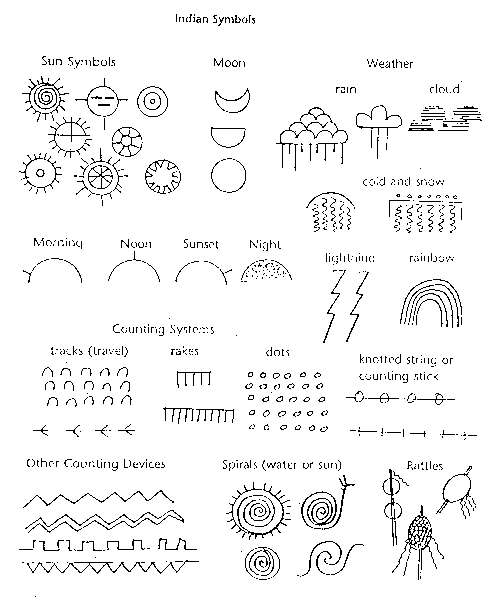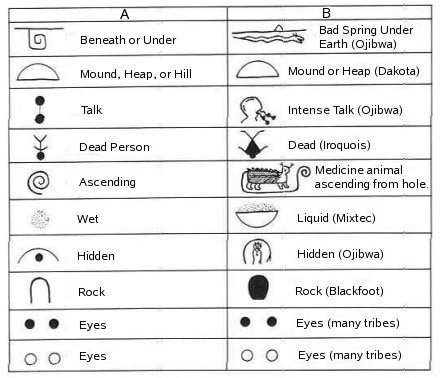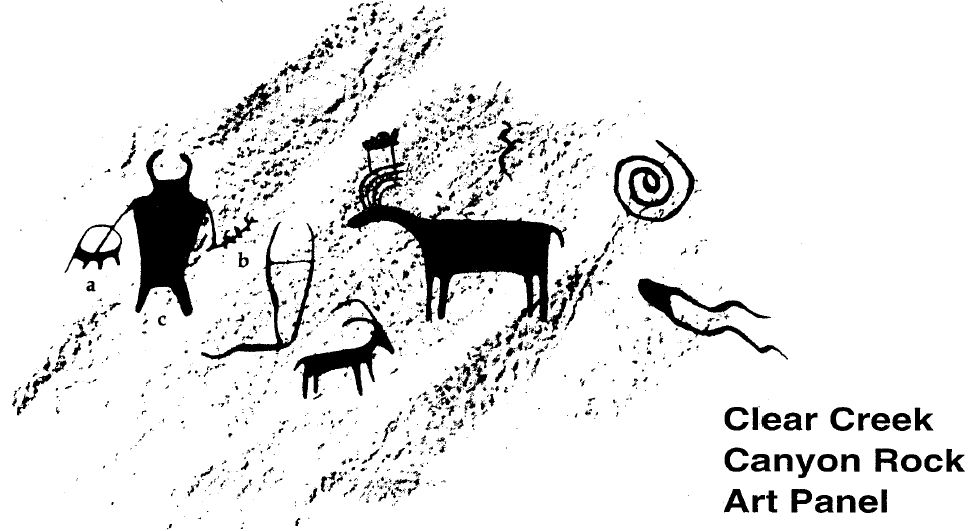

INTRODUCTION
The eighth step in archaeological research design involves interpreting
archaeological data in order to answer one’s research question. One
type of artifact from which archaeologists can collect data is rock
art. In this lab, students will use a rock art panel to develop
interpretations about past human behavior. This lab relates to the
archaeological goal of lifeways
reconstruction, or the detailed description of the past culture
of a group of people.
OBJECTIVES
TERMS
ROCK ART
Rock art is the depiction of
figures and symbols on rock outcrops,
walls, or ceilings. It may be found in caves and rockshelters or out in
the open. Rock art is considered a non-portable
form of expression,
meaning it is recorded on rock faces that cannot be transported from
one place to another. There are two major types of rock art.
Petroglyphs are engraved or
incised onto rock, while pictographs
involve the application of pigments (painting) onto rock using brushes,
blow
pipes, fingers, or another tool.
Rock art is found in the archaeological records of nearly all parts of
the world. The archaeological record of rock art extends back more than
30,000 years in some places like Europe. The longest continuous rock
art tradition spans over 20,000 among Australian aborigines. There is a
well-documented tradition of American Indian rock art in North America.
NATIVE AMERICAN ROCK ART
“Indian people throughout North America created rock art in prehistoric
times. Its meaning is mysterious and at times controversial. Some
people think that rock art is a type of storytelling. Others believe
that it depicts religious or spiritual beliefs, while still others
regard it solely as an artistic expression” (Society for American
Archaeology 1997:8).
“North American rock art is not a true writing system that can be
‘read’ or a phonetic alphabet, although some rock art specialists
attempt to decode rock art symbols. Archaeologists analyze the figures
and patterns and frequently find that different cultural groups made
different styles of rock art. Other rock art researchers analyze
stories and information about Indian people to draw conclusions about
rock art” (Society for American Archaeology 1997:8).
“Some Indian tribes have oral traditions about rock art and its
meaning. Many believe that the spirit of the makers resides in what he
or she has created; therefore, rock art is living and has a spirit”
(Society for American Archaeology 1997:8).
Native American rock art is documented in all parts of North America,
and many scholars have studied the long tradition of rock art in this
part of the world.
Rock art in Kentucky is described in a book by Coy et. al. (2004).
Diaz-Granados and Duncan (2004) edited a book on rock art in eastern
North America. Southwestern rock art is described by Schaafsma (1986).
Loendorf et. al. (2006) edited a book on rock art throughout North
America.
ROCK ART SYMBOLS AND INTERPRETATION
Common symbols in southwestern rock art are presented below (No Author
2006).

Additional interpretations of rock art symbols are provided below
(Millett et al. 2007).

CLEAR CREEK CANYON ROCK ART PANEL
A rock art panel is a set
of (presumably) associated petroglyphs and/or pictographs. The figure
below is a recreation of a rock art panel discovered in Clear Creek
Canyon in Sevier and Millard counties, Utah. The date when the panel
was created is not currently known. The canyon became part of
Fremont Indian State Park in 1985. To read
more about the rock art of Clear Creek Canyon, see Baker and Billat
(1999).
The panel was created by prehistoric
Native Americans referred to by archaeologists as the Fremont
archaeological culture. The Fremont people -- who probably
represent a series of related social groups rather than one single
group -- settled in
the canyon as early as 5200 BC (Utah Outdoor Activities 2006). Though
initially food collectors (hunter-gatherers), some domesticated plants
like maize were grown by later Fremont groups, especially after about
AD 400. They lived in pit houses, made baskets from plant material,
wore foot gear made of animal hides, and manufactured gray pottery
vessels with thin walls. The Fremont archaeological culture reached its
peak about AD 700-1250, overlapping in time with the Anasazi
archaeological culture, which is renowned for the construction of large
pueblos and cliff dwellings.

a = object held in the right hand of the large solid figure at left, b
= object held in the left hand of the large solid figure at left, c =
large solid figure at left, d = open figure with three projections, e =
two horned quadrupedal animals, f = solid object with two projections
at right, g = spiral shape at right
On the answer sheet provided in class, respond to the following
questions regarding the Clear Creek Canyon rock art panel. Each student
will complete his/her own answer sheet in pencil. The answer sheet will
be completed during class time and submitted at the end of the class
session.
Examine the Clear Creek Canyon rock art panel provided above and answer
the following four questions.
Read the four Native Americans' interpretations for symbols a, b, and c
(distributed after you complete questions 1-4) and answer the following
two questions.
REFERENCES
Baker, Shane A. and Scott E. Billat
1999 Rock Art of Clear Creek Canyon
in Central Utah. Museum of Peoples and Cultures, Occasional
Papers No. 6. Brigham Young University, Salt Lake City, Utah.
Coy, Fred E., Thomas C. Fuller, Larry G. Meadows, and James L.
Swauger
2004 Rock Art of Kentucky.
University of Kentucky Press, Lexington.
Diaz-Granados, Diane and James R. Duncan (editors)
2004 The Rock-Art of Eastern North
America : Capturing Images and Insight. University
Alabama Press, Tuscaloosa.